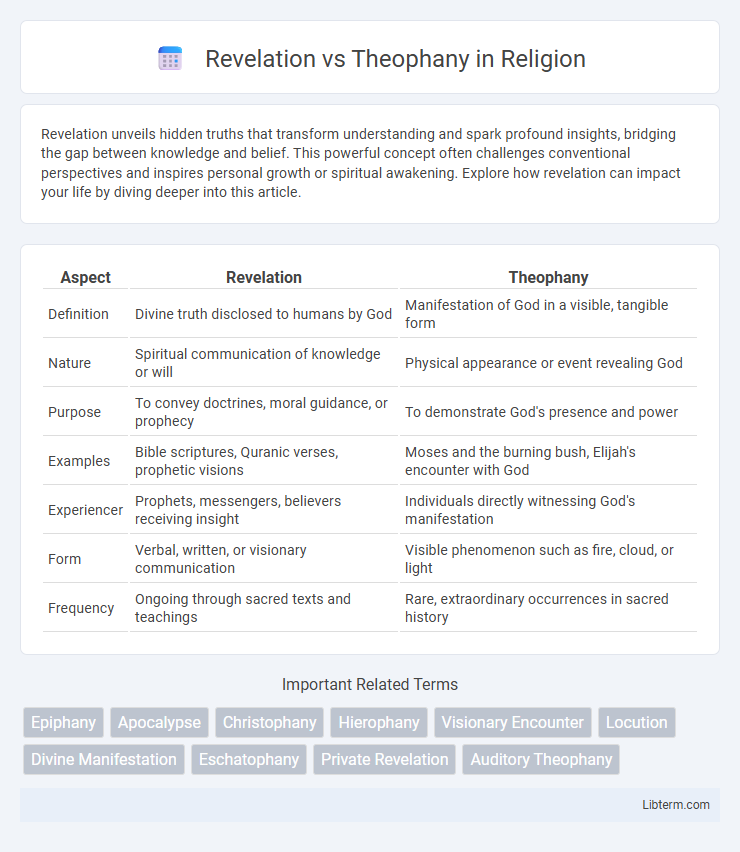Revelation unveils hidden truths that transform understanding and spark profound insights, bridging the gap between knowledge and belief. This powerful concept often challenges conventional perspectives and inspires personal growth or spiritual awakening. Explore how revelation can impact your life by diving deeper into this article.
Table of Comparison
| Aspect | Revelation | Theophany |
|---|---|---|
| Definition | Divine truth disclosed to humans by God | Manifestation of God in a visible, tangible form |
| Nature | Spiritual communication of knowledge or will | Physical appearance or event revealing God |
| Purpose | To convey doctrines, moral guidance, or prophecy | To demonstrate God's presence and power |
| Examples | Bible scriptures, Quranic verses, prophetic visions | Moses and the burning bush, Elijah's encounter with God |
| Experiencer | Prophets, messengers, believers receiving insight | Individuals directly witnessing God's manifestation |
| Form | Verbal, written, or visionary communication | Visible phenomenon such as fire, cloud, or light |
| Frequency | Ongoing through sacred texts and teachings | Rare, extraordinary occurrences in sacred history |
Understanding Revelation and Theophany: Definitions
Revelation refers to the divine disclosure of knowledge or truths by God to humans, often conveyed through sacred texts, visions, or prophets. Theophany specifically denotes a visible manifestation or appearance of God to a person, such as the burning bush experience of Moses in the Bible. Understanding these concepts requires recognizing that revelation encompasses broader divine communication, while theophany highlights a direct, sensory encounter with the divine presence.
Historical Contexts of Revelation and Theophany
Revelation and Theophany hold distinct places within historical religious narratives, with Revelation often representing the progressive unveiling of divine truth through sacred texts, such as the Book of Revelation in the New Testament, reflecting early Christian eschatological beliefs. Theophany denotes a direct, tangible manifestation of a deity to humans, frequently recorded in ancient Near Eastern traditions and exemplified in occurrences like the burning bush encounter in Exodus, signifying divine presence and intervention. These differing contexts illustrate how various cultures and epochs conceptualized communication between the divine and humanity, shaping theological frameworks and ritual practices.
Key Differences Between Revelation and Theophany
Revelation involves the communication of divine truth or knowledge directly to humans, often through scripture, prophecy, or spiritual insight, emphasizing the content of what is revealed. Theophany refers specifically to a visible or tangible manifestation of God to humans, such as the burning bush or the appearance of God on Mount Sinai, highlighting the sensory or experiential aspect of divine presence. Key differences lie in revelation being primarily about the transmission of divine knowledge, while theophany centers on the physical or perceptible encounter with the divine.
Theological Significance in Major Religions
Theophany signifies the visible manifestation of a deity to a human, emphasizing direct divine presence and interaction, which is central in Christianity's biblical accounts of God appearing to prophets. Revelation encompasses broader divine disclosure, including sacred texts and doctrinal truths revealed through prophets, forming the foundation of faith and practice in Judaism, Christianity, and Islam. The theological significance in these major religions lies in the theophany's role affirming God's immanence and the revelation's function as a continual source of divine guidance.
Scriptural Examples of Revelation
Scriptural examples of revelation include God's communication through prophets like Moses receiving the Ten Commandments on Mount Sinai (Exodus 19-20) and Isaiah's vision of the Lord in the temple (Isaiah 6). In the New Testament, the Apostle John records divine revelation through visions in the Book of Revelation. These instances emphasize God conveying His will and knowledge to humanity directly or through chosen messengers.
Scriptural Examples of Theophany
Scriptural examples of theophany include God's appearance to Moses in the burning bush (Exodus 3:2-6), His manifestation on Mount Sinai during the giving of the Ten Commandments (Exodus 19:16-20), and the divine encounter with Elijah at Mount Horeb (1 Kings 19:11-13). These theophanies emphasize direct, sensory experiences of God's presence, often accompanied by natural phenomena such as fire, smoke, or a mighty wind. In contrast to general revelation, theophanies highlight specific, tangible manifestations of the divine within Scripture.
Modes of Divine Communication
Revelation involves the disclosure of divine truths through sacred texts, prophets, or spiritual teachings, allowing humans to understand God's will and nature. Theophany refers to a visible or tangible manifestation of God, often experienced as a dramatic appearance or phenomena that directly reveals God's presence. Modes of divine communication in revelation are primarily interpretive and linguistic, while theophanies engage sensory perception and immediate experience.
Human Responses to Revelation and Theophany
Human responses to revelation often involve faith, obedience, and worship, reflecting an acceptance of divine truth conveyed through scripture or prophetic messages. In contrast, theophany elicits awe, fear, and sometimes trembling due to a direct and overwhelming encounter with God's visible manifestation. Both experiences provoke transformative recognition of the divine presence but differ in intensity and immediacy of human reaction.
Lasting Impacts on Faith and Doctrine
Revelation provides foundational truths that shape core doctrines and guide ethical living, establishing enduring theological frameworks within religious traditions. Theophany, as a direct divine manifestation, often strengthens personal faith and inspires devotional practices, reinforcing believers' sense of divine presence and authority. Together, these experiences influence religious interpretation and community identity by anchoring beliefs in both revealed scripture and tangible encounters with the divine.
Modern Perspectives on Revelation vs Theophany
Modern perspectives on revelation emphasize ongoing, dynamic communication between the divine and humanity, highlighting personal and communal experiences of truth. In contrast, theophany is understood as a specific, often dramatic, manifestation of God's presence, typically documented in religious texts. Contemporary theological discourse explores how revelation encompasses both theophanic events and the broader, interpretive process through which divine knowledge is disclosed and internalized.
Revelation Infographic

 libterm.com
libterm.com